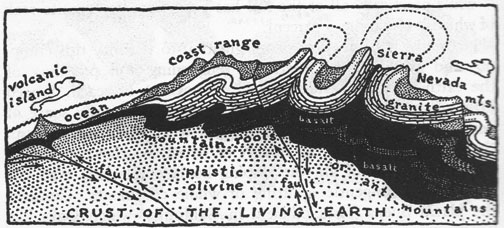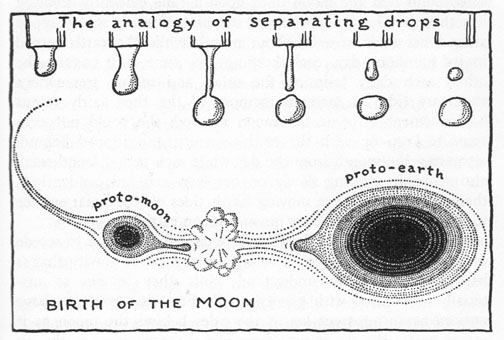I just had the pleasure of reading the first volume of Guy Murchie’s Music of the Spheres, titled The Macrocosm, and I can see that a lot has been learned about Earth, the Moon, and planets since I was born. Take this sectional illustration of Earth’s crust for example:

A rather outdated cross section of California
Note the complete absence of tectonic plates. Note that the Sierra Nevada is represented as a folded range, which it’s not. Furthermore, today we don’t think there’s a basalt layer beneath North America, and in fact, we don’t think there’s any root at all beneath the southern Sierra. That last bit has been discovered rather recently.
Another example of the obsolescence of this volume are the two outdated hypotheses of Moon formation. The preferred hypothesis at the time of printing appears to have been a fission model, which is no longer accepted:

An outdated moon-birth hypothesis
Of course this book was written before astronauts stepped on the moon — before we began to collect samples of lunar rock. Murchie can only guess that the Moon is a solid ball of granite, whereas today we know the Moon to be a stratified body like Earth, with a crust composed of basalt and anorthosite. We’ve obviously learned a thing or two about the Moon since the 1960s.
We’ve also learned a lot about the interior of Earth since then. We now believe that the source of most of Earth’s internal heat is nuclear radiation, and that Earth has a solid inner core. We’ve learned about plate tectonics and the greenhouse effect. We’ve found rings around Jupiter, Uranus, and Neptune, we’ve discovered a number of dwarf planets and over 400 extrasolar planets, and we’ve discovered over 130 planetary satellites (moons), including some rather significant moons of Neptune. We’ve even watched a comet collide with Jupiter! With all that, we’re not as ready to send astronauts to Mars as Murchie and Werher von Braun were in 1961, but we’re doing quite well sending robots.
Of course we should not blame Murchie for what we didn’t know in the 1960s. Still, there are some areas where Murchie may have fallen short even for his time. There are places where he omitted pertinent facts, such as the role of bacteria in producing oxygen in the early atmosphere. There are also places where he may have misrepresented the basic science, such as with his treatment of heating by compression of solids (pg. 148–50). Murchie seemed to assert that pressure alone will cause any substance to glow, but a solid (so long as it behaves as an incompressible solid) will resist compression under high pressure. If a material does not compress under pressure, it will not heat, and it will not glow.
Digressions, Flourishes, & Religion
Murchie’s composition was sometimes distracted and his prose was sometimes needlessly flowery. He would sometimes graft in digressions — often religious — that could seem extraneous and even forced:
The dozens of human jet-age stargazers waiting around for the zero hour of launching then always remind me of the faithful shepherds of similar deserts in the ancient Holy Land who have long had an equally great faith that the world can be changed. Even though on the face of it the two kinds of change are different, I think they are also profoundly related in a way that will one day be made manifest to all.
Music of the Spheres, page 24
That’s more than a statement of belief; it’s a prophecy (too ambiguous to be anything else).
I don’t mean to denigrate the idea of spiritual progress — or political progress for that matter, but I don’t understand what Murchie is getting at here: what do the Bedouin have to do with progress?
Murchie also made some rather reasonable points in favor of religion, such as pointing to Johannes Kepler’s religious motives for seeking natural law — which he Murchie equated to divine justice — in the heavens. And I ought to give Murchie credit for having kept his religion out of the science itself. Murchie can be credited, for instance, with having resisted the temptation to follow the precedent of the Bahá’í “perfect exemplar” `Abdu’l-Bahá’, who spoke out against the idea that we are descendants of animals.
… we are the cousins, if not the descendants, of the very most successful of all the most daring of fish, …
Page 25
The Heart of the Matter
Notwithstanding these faults, I’m inclined to believe that Murchie’s core ideas transcend such particulars. Indeed, one wonders why he included quite so many particulars, knowing that such detail might water down the message. Perhaps Murchie was striving to make Music of the Spheres a comprehensive historical survey of physical science, but that might have been overly ambitious given his affection for big, broad ideas. Perhaps had he dealt separately with (1) music in nature, (2) math in nature, and (3) the boundless frontiers of discovery, this book would have been more enduring and more versatile.
A Segue into the Mysteries of Life
As Murchie stated in the forward to the 1967 edition of Music of the Spheres, he intended the two-volume set to form a larger set with his next book, which he intended to name Melody of Life, but was eventually named The Seven Mysteries of Life.
I am six years along in writing a sequel and companion volume to Music of the Spheres on the subjects of life and mind. The work, now about half done, will probably be titled Melody of Life, and in due time I hope it will be offered with the present book as an integral set.
G.M., 1967
Indeed, the two books share a central thread or three, including the core theme of Music of the Spheres — what Murchie calls the abstract, musical nature of the world. The Seven Mysteries of Life actually began as the chapters of Music of the Spheres that didn’t make the cut in 1961.
This time it was about life, philosophy and things I didn’t have space enough to include in my Music of the Spheres. It was another case of one book’s leading right into the next for fulfillment.
Guy Murchie, The Soul School, pg. 352